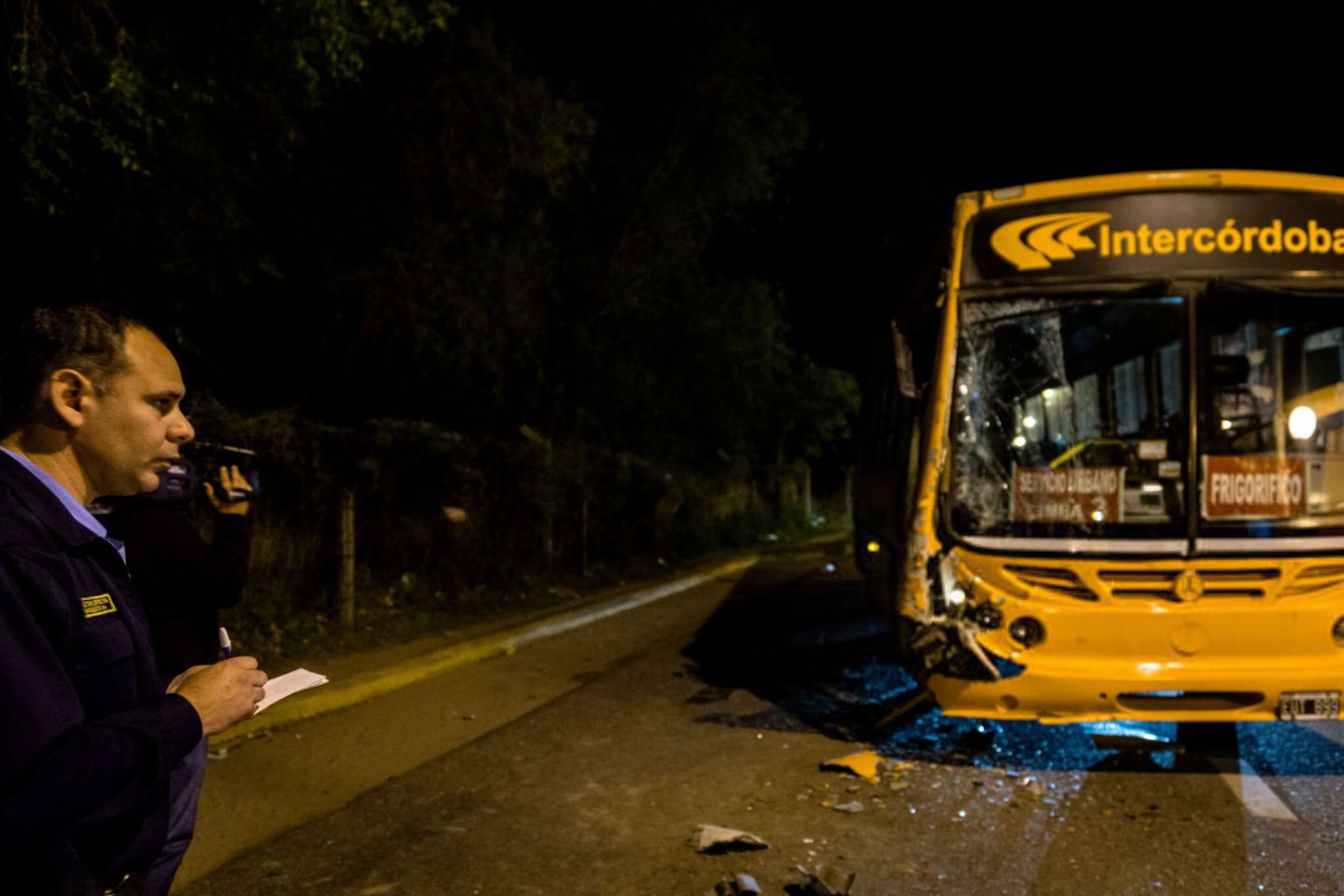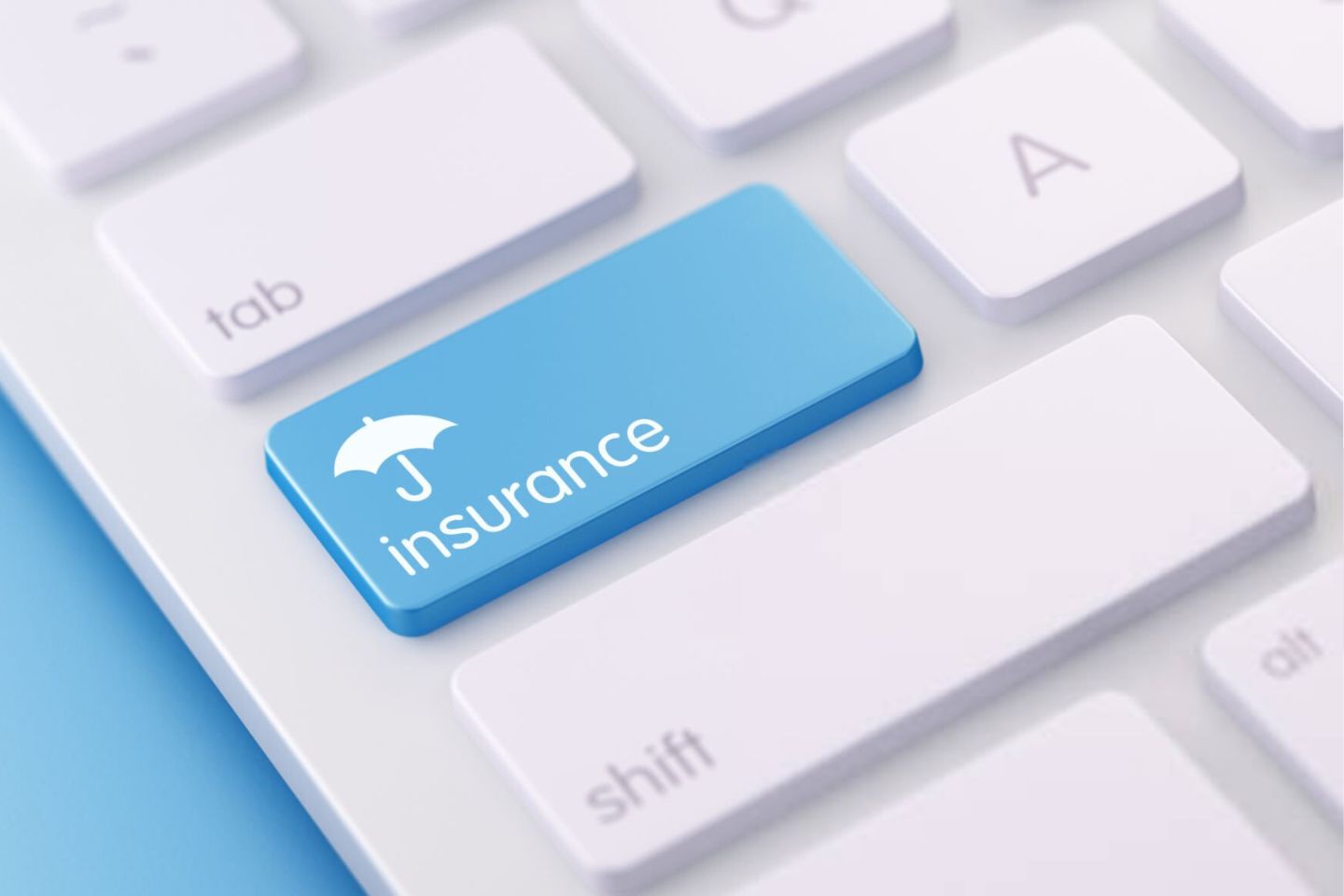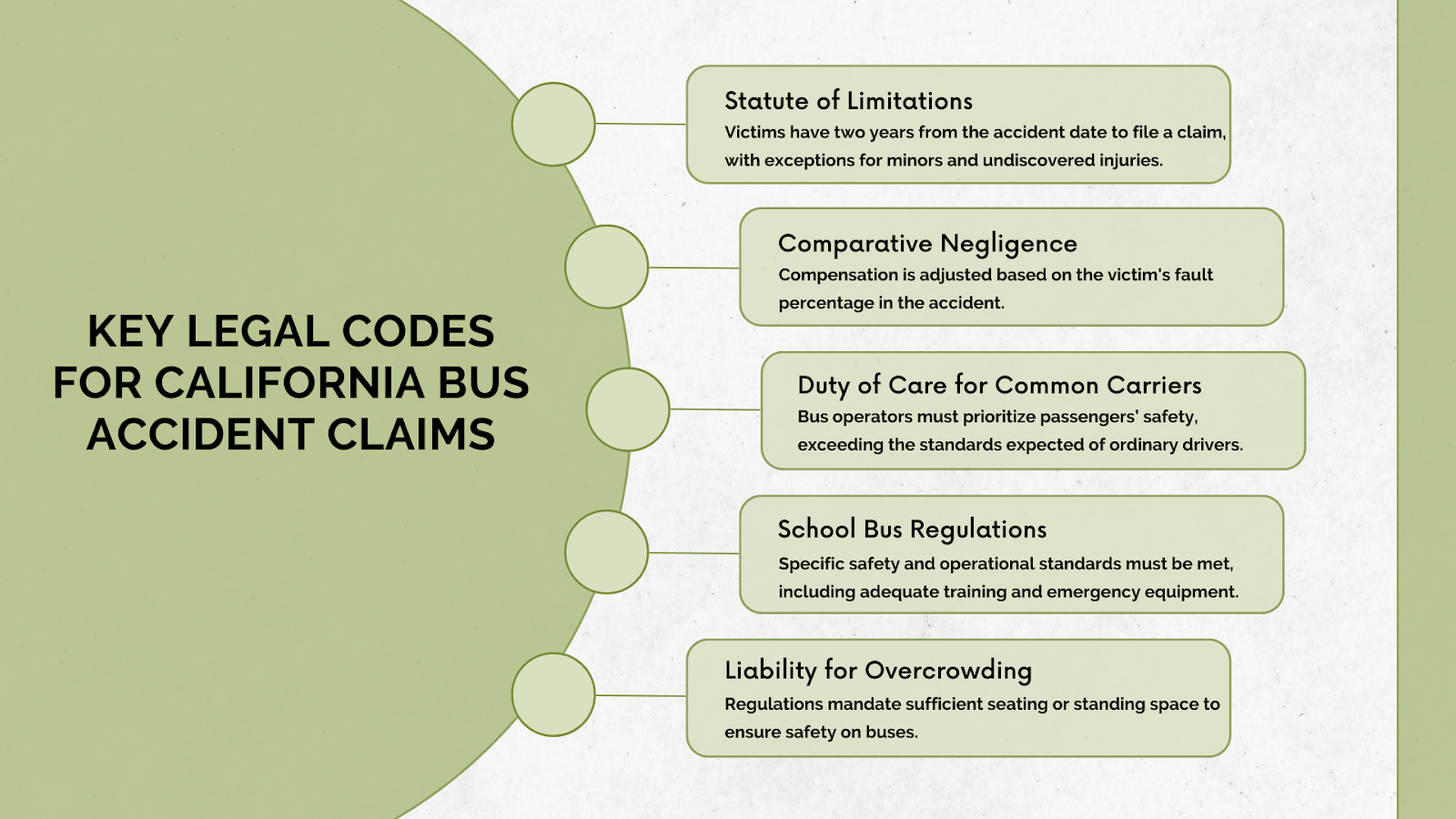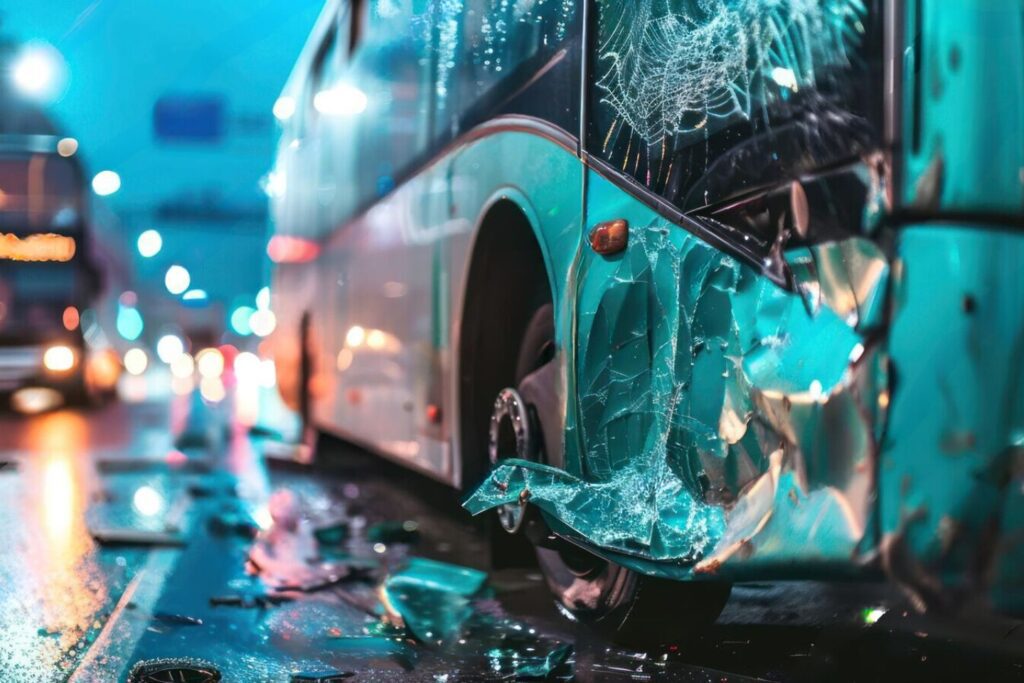Navigating the aftermath of a bus crash in California can be as distressing as the incident itself. In 2019, the United States witnessed 2,734 fatal crashes involving trucks and buses. Such accidents leave victims with physical injuries, along with financial and emotional stress, pushing many towards seeking rightful compensation.


If you have been involved in a bus crash in California, we are here to help you pursue your legal claim. In this blog, we delve into the legal complexities one should consider, such as determining liability and compensation. Understanding the details of pursuing a personal injury claim can be the first step toward securing the justice victims deserve.
Immediate Steps to Take After a Bus Crash in California


A bus crash is both a traumatic experience and a critical moment for taking the right steps toward ensuring your safety, health, and legal rights. Below is a comprehensive guide on what to do immediately following a bus crash in California.
Ensure Your Safety and Check on Others
In the immediate aftermath, if you’re able to move, prioritize getting to a safe area away from the road to avoid further accidents, especially on high-speed roads like freeways. California law, specifically the Move Over Act (California Vehicle Code 21809), requires drivers to move over or slow down when approaching stationary emergency vehicles, which includes the scene of your accident.
If it’s safe to do so, check on others. Offer help to those who might be in shock or unaware of their injuries. Remember, under California’s Good Samaritan Law (Health and Safety Code Section 1799.102), you’re protected from civil liability when providing non-medical help in good faith at the scene of an emergency. This means you can act without fear of legal repercussions, provided your actions are intended to help and not harm. Simple acts, such as using a jacket to keep someone warm, applying pressure to a bleeding wound with a clean cloth, or even using your phone’s flashlight to help visibility in dark conditions, are all forms of aid.
Call 911
It’s crucial to give a clear and concise report to the emergency operator, stating the specific location (note any landmarks or exit numbers) and the nature of the incident. Mention the number of vehicles involved and any hazards that may require additional resources, such as the fire department.
The responding officers will fill out a traffic collision report, a document that will be vital for insurance claims and any legal proceedings. Be sure to ask how you can obtain a copy of this report for your records.
Gather Evidence
Document everything: the position of the bus, any skid marks on the road, weather conditions, and the immediate surroundings. This visual evidence can later help reconstruct the accident and establish fault.
Moreover, witnesses can play a crucial role in your case. Politely ask for their contact details. If they’re willing, take a quick video statement of their account of the accident using your smartphone. This can be invaluable if memories fade or if there’s a dispute about the events.
Seeking medical attention immediately after a bus crash is not just crucial for your health; it’s a vital step in any potential legal action you might take. California has established a comprehensive framework to ensure victims of accidents receive prompt and effective medical care.
Immediate Medical Attention
Under the California Health and Safety Code, Division 2.5, Sections 1797-1799.200, the state ensures a structured and efficient response to emergencies, including bus crashes. This act ensures that trained personnel are available to provide care at the scene of an accident.
Immediate medical care is important because some injuries, especially internal ones, may not show symptoms right away. For example, internal bleeding or a concussion can have delayed symptoms that are potentially life-threatening if not treated promptly.
When you seek medical attention immediately, it establishes a documented link between the accident and your injuries, which is critical in personal injury cases. This documentation is invaluable in proving the extent and cause of your injuries to insurance companies or in court.
Report the Incident to the DMV
After a bus crash in California, one of your legal obligations includes reporting the incident to the Department of Motor Vehicles (DMV). According to California Vehicle Code Section 16000, this requirement is applicable if the accident results in property damage exceeding $1,000 or if anyone is injured or killed.
The specific document you’ll need to fill out is the SR-1 Report of Traffic Accident, which is available on the California DMV website. This form asks for detailed information about the accident, including the date, time, and location, as well as personal information for the drivers involved, insurance details, and a description of the injuries and damages.
You have 10 days from the date of the accident to submit the SR-1 form to the DMV. Failing to report within this timeframe can result in penalties, including the suspension of your driving privileges.
Please note that the accuracy of your SR-1 report is crucial. Inconsistencies between your DMV report, the police report, and any insurance claims can lead to disputes and potentially undermine your credibility. Ensure that all facts are consistent across documents. This includes the correct spelling of names, accurate vehicle descriptions, and a factual representation of the events and damages.
Contact Your Insurance Company


While it’s necessary to inform your insurance about the accident promptly, be cautious with the information you share. Stick to the facts, and don’t speculate about fault or injuries until you’ve consulted with a personal injury lawyer.
Familiarize yourself with your insurance policy’s coverage for accidents involving public transportation or commercial vehicles. This understanding will be crucial when discussing your claim with your insurer or attorney.
Dealing with the aftermath of a bus crash can be overwhelming. Contact the Personal Injury Center for comprehensive guidance. Our experts will connect you with leading personal injury attorneys in your area to ensure you pursue the justice and compensation you deserve.
Identifying Liability in California Bus Accidents
In the aftermath of a bus crash in California, determining who is liable is a complex process that involves understanding the roles and responsibilities of various parties. Here’s an overview of potential defendants and the specific legal contexts that might apply to them.
Bus Driver
- Key Considerations: The driver’s actions leading up to the crash are scrutinized for negligence such as distraction, impairment, or violations of traffic laws. Evidence such as traffic camera footage, driver logs, and eyewitness accounts can be critical.
- Relevant Law: California Vehicle Code Section 23152 highlights DUI, underscoring the importance of safe and sober driving.
Bus Company or Operator
- Key Considerations: Liability can stem from inadequate driver training, failure to conduct proper background checks, or neglect in bus maintenance routines.
- Relevant Law: California Public Utilities Code Section 1031 outlines operational standards and licensing requirements, emphasizing the company’s duty to ensure the safety of its services.
School Districts or Government Entities
- Key Considerations: For buses operated by public schools or city transit systems, the focus may be on the entity’s oversight, vehicle maintenance, and route safety assessments. Special notice requirements exist for claims against these bodies, impacting the timeline for legal actions.
- Relevant Law: Government Code Section 911.2 specifies the 6-month period for filing a claim, a crucial prerequisite for lawsuits against public entities.
Bus Manufacturer or Parts Manufacturer
- Key Considerations: Investigations often look into whether the bus crash was caused by a vehicle defect or faulty components, such as brake failure or steering issues. Safety notices issued by the manufacturer can be significant evidence.
- Relevant Law: Under Civil Code Section 1714.45, liability for product defects, including design flaws or inadequate warnings, is established. This places a high standard on manufacturers to ensure consumer safety.
Other Drivers
- Key Considerations: The behavior of other road users leading up to the accident, such as aggressive driving, failure to yield, or distractions, can contribute to the crash. Multi-vehicle accident analysis may involve reconstructing the accident scene to understand these dynamics.
- Relevant Law: The Basic Speed Law (Vehicle Code Section 22350) is often cited in cases where another driver’s speeding or reckless behavior is a contributing factor.
Municipalities or Road Authorities
- Key Considerations: The condition of the roadway, visibility of traffic signs, and adequacy of road design to accommodate bus traffic are factors. Poorly maintained roads or inadequately marked construction zones can lead to hazardous conditions for buses.
- Relevant Law: The responsibilities of local and state road authorities are detailed in the California Streets and Highways Code. Claims related to road conditions also require adherence to the claim filing process outlined in the Government Code.
If you’ve been injured in a bus crash, get in touch with the Personal Injury Center. We offer expert advice and will link you to experienced personal injury lawyers who can help navigate your claim to a successful resolution.
Legal Codes Impacting Bus Crash Claims in California


When navigating the aftermath of a bus accident in California, several legal codes play a crucial role in shaping the outcome of personal injury claims.
Here’s a look into these codes.
Statute of Limitations
California Code of Civil Procedure Section 335.1 sets the statute of limitations for personal injury claims at two years from the date of the accident. For bus accidents, this means victims have a two-year window to file a lawsuit against the responsible parties. Missing this deadline typically results in the loss of the right to sue.
However, there are notable exceptions to this rule that can extend or alter this period. For example, for minors involved in a bus accident, the statute of limitations does not begin until they reach the age of 18.
Another exception applies if the injury was not discovered immediately despite reasonable diligence. In such cases, the statute of limitations may begin from the date the injury was discovered, rather than the date of the accident.
Comparative Negligence
California Civil Code Section 1431.2 introduces the concept of comparative negligence, which allows for the allocation of fault among all parties involved in an accident. In bus accidents, if the victim had any role in causing their own injuries, their compensation could be reduced by their percentage of fault. Under this rule, if you are found to be 10% at fault for the incident, your compensation will be reduced by 10%.
Duty of Care for Common Carriers
California Civil Code Section 2100 establishes a heightened duty of care for common carriers, including bus operators. Common carriers are obligated to use the utmost care and diligence for their passengers’ safety, a standard higher than that required for ordinary drivers. This encompasses rigorous driver training, meticulous vehicle maintenance, and adherence to all safety regulations and protocols.
This principle is critical in bus accident cases, as it provides a basis for arguing that a bus company or driver failed to meet their stringent responsibilities.
School Bus-Specific Regulations
California Vehicle Code Section 545 sets specific regulations for school buses, including special training for drivers, operational standards, and safety protocols. Violations of these specific regulations can contribute to establishing liability in accidents involving school buses.
If a school bus accident occurred and it was discovered that the bus lacked the required safety equipment, this could directly impact the liability and outcomes of personal injury claims. This includes requirements such as proper lighting or emergency exits.
Liability for Overcrowding
California Public Utilities Commission (CPUC) Regulations set forth regulations to prevent overcrowding on buses, mandating that all passengers must have seats or proper standing space. This includes having sufficient handholds and railings for standing passengers and maintaining clear exit paths. Violations leading to injuries, especially in cases where passengers are standing in aisles or are otherwise unsafely accommodated, can be grounds for liability.
Overcome the challenges of a bus accident claim with professional help. Reach out to the Personal Injury Center. Our team is ready to provide the assistance you need. We will connect you with top personal injury attorneys, helping you secure your rightful compensation.
Key Takeaways
|



